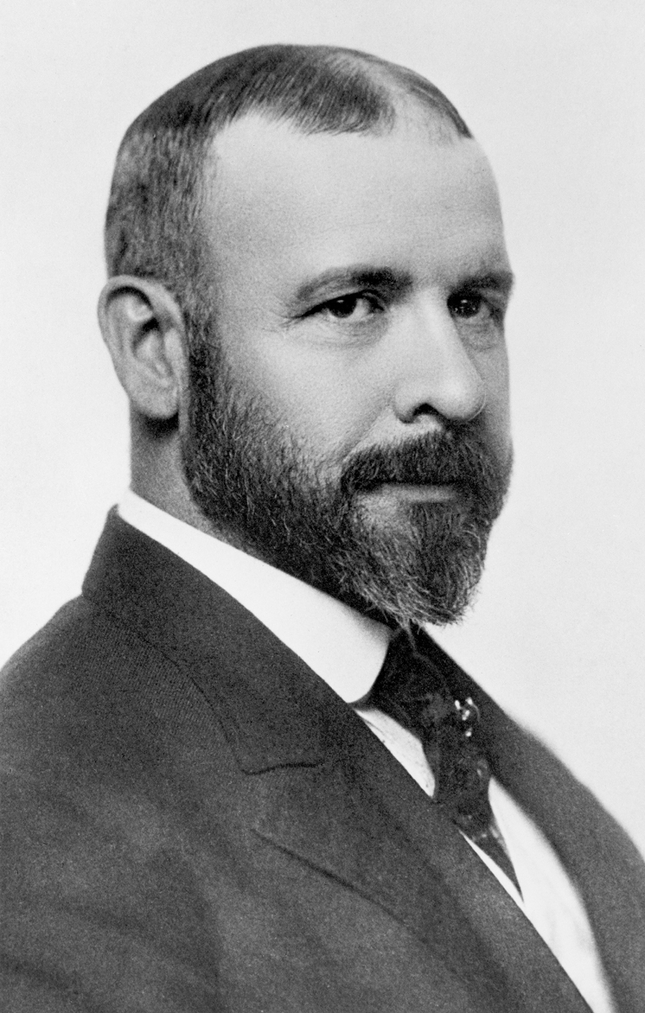
How Louis Sullivan Shaped Chicago’s Skyline
Published on September 19, 2024
Louis Sullivan’s Charnley-Persky House is on our walking tour of Chicago’s Gold Coast and Old Town neighborhoods. You can also see Sullivan’s gravesite and two tombs he designed on our Deep Pockets of Graceland Cemetery adventure.
By Dave Lifton (@daveeatschicago)
Of all the architects who created Chicago’s cityscape, perhaps none is as pivotal as Louis Sullivan, who helped invent the skyscraper and whose approach and theories influenced generations of disciples.
Born in Boston in 1856, he enrolled at MIT’s architecture school when he was 16. By this time, his parents had moved to Chicago, and he joined them after a year as the city needed help rebuilding after the Great Chicago Fire. Sullivan worked for a few months at William Le Baron Jenney’s practice before leaving for Paris to spend a year at the École des Beaux-Arts.
He returned to Chicago in 1875 and, four years later, got a job with Dankmar Adler’s firm. Six years later, Sullivan became Adler’s partner, with Adler focusing more on the structural and technical details and Sullivan as the designer. Along with Jenney, Burnham & Root, Holabird & Roche, and others, Adler & Sullivan would soon transform Chicago with the skyscraper.
The Auditorium Theater (1889) on Michigan Ave. is widely considered to be the birth of Sullivan’s style. He built upon the Richardsonian Romanesque style (see the Glessner House on Prairie Ave.), rejecting neoclassical and Victorian ideas in favor of a more organic, nature-based approach. One of the draftsmen who worked on the Auditorium Theater was Frank Lloyd Wright. The mentor and protégé collaborated heavily on one of the few homes Sullivan built, the Charnley-Persky House (1891) in the Gold Coast.
Although it would be known as the ‘Chicago School’, a pair of Adler & Sullivan skyscrapers in other cities allowed Sullivan’s vision to take flight. St Louis’ Wainwright Building (1891) solidified the concept of an all-steel construction with a tripartite design and decorated terra cotta, and the Guaranty Building in Buffalo (1896) had more elaborate ornamentation.
The beautiful cornices, pedestals, and arched windows at the tops of the buildings were more than just decoration; they drew attention to their height. “It must be tall, every inch of it tall,” he wrote in 1896. “The force and power of altitude must be in it. The glory and pride of exaltation must be in it.” In the same essay, Sullivan expressed that idea in what became the credo of American architecture.
“It is the pervading law of all things organic and inorganic, of all things physical and metaphysical, of all things human or superhuman…that the life is recognizable in its expression, that form ever follows function,” he wrote in 1896. “This is the law.”
But by then, there had been significant turmoil in Sullivan’s professional life. Wright opened his own practice in 1893, taking Sullivan’s philosophy in a different path—creating greater harmony between the building and the flatness of the Midwest—on a series of homes which led to the birth of the Prairie School. Two years later, Adler resigned after commissions slowed down due to a recession.
On his own, Sullivan created what may be his masterpiece, the 1899 store for Schlesinger & Mayer at the corner of State and Madison. It’s distinguished by a dark green cast-iron façade inspired by Midwestern foliage surrounding the first two floors. Carson Pirie Scott took it over in 1904, staying until 2007, and it has been a Target since 2012.
But the 20th century wasn’t kind to Sullivan. He separated from his wife and was drinking heavily. His stubbornness prohibited him from taking work from clients he felt were beneath him, and he refused to compromise his vision to accommodate their wishes. Much of the money he made went to his creditors and his estranged wife, and he often relied on the generosity of friends and colleagues like Wright.
Between 1906 and 1920, his main commissions were a series of eight “jewel box” banks in small Midwestern towns. His final creation was the Krause Music Store (1922) in Lincoln Square, two years before his death. Sullivan is buried in Graceland Cemetery.
After falling into disrepair, many of Sullivan’s Chicago buildings were unfortunately demolished in the name of urban regeneration. Photographer Richard Nickel, understanding their historical significance, lobbied to preserve them. When unsuccessful, he took pictures and salvaged ornamentation from the demolition sites. In 1972, he was taking what he could from Adler & Sullivan’s Chicago Stock Exchange (1894) when a wall collapsed on him, killing him. Nickel’s death drew attention to the cause of architectural preservation. Today, there are only 21 Louis Sullivan-designed buildings in Chicago, many of which have been landmarked. Nickel’s entire archives were donated to the Ryerson and Burnham Libraries at the Art Institute of Chicago.

The Adventure starts when you say it does.
All eATLAS Adventures are designed and built by experienced eATLAS Whoa!Guides. They're always on. Always entertaining. And always ready to go.
Check out our Adventures!